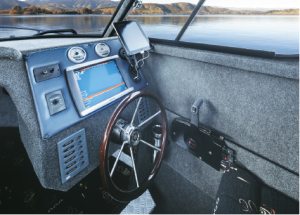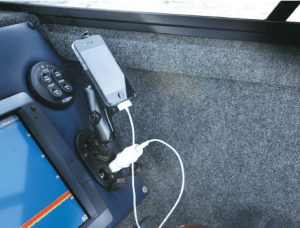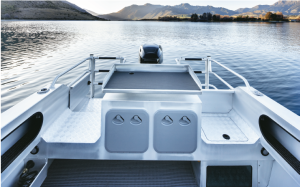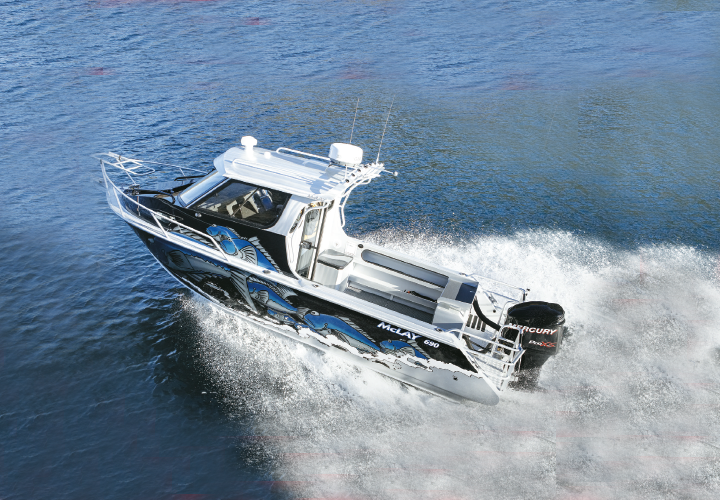The main difference is that it is slightly wider, higher in the topsides and has a raised cockpit sole. This has allowed for a larger fuel tank, up from 170 litres to 200 litres, an underfloor ‘kill’ tank and provision for a fresh water tank, plus still allowing for sufficient buoyancy. This would all have been impossible in the 680 as there would not have been enough buoyancy capacity retained under the sole.
“These changes were very much customer driven”, says McLay Boats MD, Steve McLay. “While the 680 has been around in various versions for over ten years and has been our best seller it was time for a fresh new model”.
However, in a sense the 690 has already been preceded by the 735S, a boat I tested last year. Big difference is the 735S is the inboard/stern drive version of the new 690, so just about everything from the cockpit forward is the same.
Under water the hull is very similar, albeit 80mm wider and the two pressed strakes either side of the hull have been reduced by 50% in profile to provide a softer ride at speed. With the raised floor there is also an extra internal stringer either side of the 5mm hull and the weight has increased over the 680 by around 200kg.
Winner of the Aluminium Fishing Boat, 6 – 7 metres category, in the 2011 Hutchwilco New Zealand Boat show, the McLay 690 Cruiser Hardtop is one of nine boats in the McLay Hardtop Cruiser Series, which ranges from the 6.1m 600 through to the 8.1m 775.
Over the years I have had the privilege of testing plenty of McLay boats, right from the very early days when they were first produced under the Toko Engineering & Marine banner. One thing that really stands out is the fact that Steve McLay, the man behind the brand, has never been afraid to be a little different.
In the early years he painted his boats wild colours, when just about everyone else was still happy with unpainted aluminium. He was an early exponent of the hardtop and today produces one of the largest production ranges on the market. It has proven to also be the company’s biggest selling line.
Today he is into hull graphics – wild graphics that really stamp a personal signature on every boat. Interestingly, until now no two graphics (around $5000 extra) have been the same, but a client has ordered a 690 with exactly the same blue fish design as the one on the boat tested.
The last McLay I reviewed was the 735S, a diesel powered stern drive version, tested on a mirror smooth Auckland Harbour. Prior to that was the 775HT, the flagship of the fleet, in which I experienced some of the roughest water ever for a boat test. Those who read the article in Propeller magazine will remember the atrocious conditions we had crossing Foveaux Strait (twice) and then it was just as bad on a horrendously rough Lake Te Anau. So as for experiencing McLay boats in a variety of sea conditions, I can say in confidence that I have done it all. Rough or smooth, they certainly do the business and the bigger they get the better they are.
I say this because the McLay 690 Cruiser in this story I never actually got to run in. I had arranged with Steve to meet in Wanaka and along with some great support from the guys at Tallon who kindly agreed to loan us their helicopter for the photo shoot, the plan was to spend an afternoon on the picturesque Lake Wanaka. Unfortunately, the day we had arranged was the same time as the Chilean ash cloud was hovering around the South Island. It looked okay in the morning, for while Dunedin, Invercargill and Christchurch airports were closed, Queenstown was still open. That was until we were about 30 minutes away, when the pilot informed us that the ash was too low and we were turning back to Auckland.
With the plans already in place for the test, but myself in Auckland, I got the rest of the team to go ahead with the photo shoot, while I headed back home. Unfortunately, for the two days the boat was available, before being delivered to its proud owner in Te Anau, all the South Island airports remained closed, so I never made it.
As it was the conditions on the lake were mirror smooth and the photo session went off without a hitch. We managed to get the fuel and performance figures off the Garmin GPS and from photos and a long phone call to Steve, I managed to put together the rest of the story. However, I did have the opportunity to walk through the boat at the boat show, so I was already somewhat familiar with the layout.
McLay 690HT Open Plan
The layout follows very similar lines to the 735S with an enclosed wheelhouse and forward cabin, plus a large workable cockpit. This is a boat designed for fishing (the graphic on the side gives that away), but it is also a weekender and comes with everything from a head to a freshwater pump.
Forward, the vee berth has in-fills to make a huge over 2m long ‘crash pad’. There are large storage areas under the squabs and in very wide side trays, plus a head under the centre squab. Plumbed in or chemical toilets are available. All the interior is fabric lined so there’s very little indication of aluminium construction.

Without any full height bulkhead separating the cabin from the wheelhouse, you really get the feeling of plenty of space. To port there are two glove boxes, one above that’s open and one below that’s enclosed.

Opposite, the helm is much the same as in the 680, although in our test boat we had an optional vinyl covered dash. This is plenty big enough for large screens, which in our case was a 12” Garmin. Twin SmartCraft gauges looked after all the running and fuel data, plus there were twin BEP switch panels and the controls for the Maxwell RC8 winch.
McLay Boats is now offering the new Tallon Elite Receiver as standard on all its NZ hardtop models. This encompasses the strength and adaptability of a standard Tallon receiver but adds power and a USB socket also. You can securely hold you smart phone or tablet, plus power it or connect to the stereo knowing it’s safe and secure.

AS in the 735S, the big front screen of the wheelhouse has been moved forward 150mm, which has dramatically reduced the chances of taller people hitting their heads on the screen console in rough water. Above is the Fusion stereo /iPod head and VHF.

Twin bin seats that also come with a central infill, complete with backrest, provide seating in the wheelhouse. This provides for a full width bench seat for three to four people when the rear door is closed. Under the port squab is provision for a small fridge and to starboard there are split storage lockers. The sliding windows and bi fold glass doors on the aft wheelhouse bulkhead are optional, but to date every 690 ordered has them. Sliding side windows let in plenty of ventilation when required. Close up the wheelhouse and you have a warm retreat if you are into your winter boating, or need shelter on a rainy summer’s day.
Working Cockpit
Being a cockpit that has been designed for serious fishing, as you’d expect there is everything you need for the task. Forward are a couple of bin seats, one with a removable fish bin, and the other for storage. They are a great place to sit when underway and also with the overhang of the wheelhouse roof, some protection from the weather when outside.
Between the two bin seats is a very deep wet locker and either side of the cockpit side trays that are big enough to stow dive tanks. There’s also another couple of coaming shelves for short rods and various other fishing bits and pieces that you seem to need. The rocket launcher on the hardtop now takes eight rods (previously six) and they are within reasonable reach from the cockpit.
I particularly like what McLay has done with the transom area. Either side of the central bait station, mounted above twin lockers for items such as batteries, are twin steps through to the boarding platform. Both have alloy hinged rear gates, with the port side housing a live bait tank complete with front window. They also make another couple of handy seats.

Like many McLay boats I have been on, the boarding area is surrounded by a railing cage with drop-down ladders either side. It’s also designed so that access from one side to the other is uninhibited, a bonus if you are playing a big fish.
Even Better
Boat #1 was sold to a previous McLay 680 owner who commented that compared to the 680, the 690 offers a better, more comfortable ride and there’s a real feeling of more space. At the time of going to press, McLay reported four 690s on order and a number more being quoted. “In this very tight market I would have to say that’s a success and a positive reaction, which is encouraging”, says Steve. Interestingly, all the boats sold to date have fully enclosed wheelhouses and are outboard powered.




